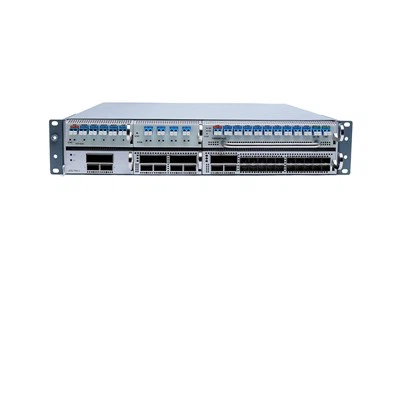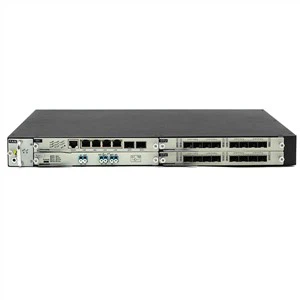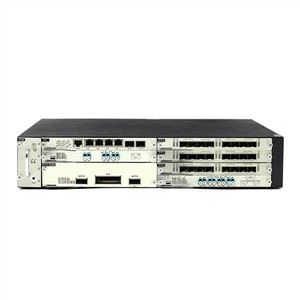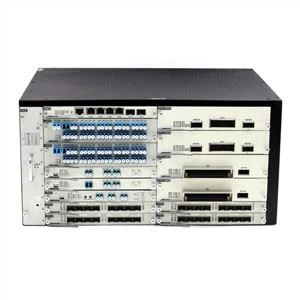DWDM can combine and transmit different wavelengths simultaneously in the same fiber. For example, if the capacity of a single fiber is 2.5 GB / s, DWDM can multiplex eight optical fiber carriers (OC) into a single fiber, which can expand the fiber capacity from 2.5 GB / s to 20 GB / s. Common configurations are 4, 8, 16, 32, and 40 channels. At present, due to DWDM, single fiber can transmit data at up to 400gb / s.
The current DWDM system can provide 16 / 20 wave or 32 / 40 wave single fiber transmission capacity, up to 160 wave, with flexible expansion ability. It can make full use of the huge bandwidth resources of optical fiber, so that the transmission capacity of one optical fiber is several times to dozens of times higher than that of single wavelength transmission, which greatly saves the optical fiber resources and reduces the cost of line construction.
Compared with CWDM, DWDM with closer wavelength spacing can carry 8-160 wavelengths on one fiber, which is more suitable for long-distance transmission. With the help of EDFA (erbium doped fiber amplifier), DWDM system can work in thousands of kilometers.

Compared with 4G, 5g needs higher speed optical module, larger capacity optical transmission system, more flexible networking and more efficient optical layer scheduling. The application of DWDM can carry multiple wavelengths (channels) on one optical fiber, which makes it the main means of expanding the capacity of optical fiber communication network. In DWDM system, each wavelength channel transmits data transparently without any processing of channel data. Therefore, it is convenient to expand the capacity by increasing the number of multiplexed optical wavelength paths. It allows operators to make full use of the existing network wiring and realize smooth upgrading and expansion without major changes or replacement of the existing network.
DWDM: the wavelength interval is between 0.2 nm and 1.6 nm, and the wavelength interval is relatively dense. Compared with CWDM, it has larger capacity, more channels, supports EDFA optical amplification, and has a longer transmission distance.One of the key advantages of DWDM is that its protocol and transmission speed are independent. The network based on DWDM can use IP protocol, ATM, SONET / SDH and Ethernet protocol to transmit data, and the data flow processed is between 100MB / s and 2.5gb/s. In this way, DWDM based network can transmit different types of data traffic at different speeds on a laser channel. From the point of view of QoS, DWDM based network can quickly respond to the bandwidth requirements and protocol changes of customers in a low-cost way.
DWDM is a high-performance WDM transmission technology for network expansion. It uses the huge bandwidth of single-mode fiber in low loss area to couple different wavelengths of light into one fiber for transmission. It can provide 4 ~ 44 channels of single fiber transmission channel, effectively expand the communication capacity of network system, monitor the channel quality in real time, and check the network fault.
At present, DWDM technology is mainly used in long-distance transmission networks such as LAN and man which need to expand communication capacity. DWDM can provide channel spacing of 50 GHz (0.4 nm), 100 GHz (0.8 nm) or 200 GHz (1.6 nm). Most DWDM systems use 100GHz and 50GHz. Make full use of the low loss band of optical fiber, increase the transmission capacity of optical fiber, and make the data transmitted by one fiber increase to several times.
Dual / single fiber bidirectional transmission
In the dual fiber system, the same wavelength is used in both transmitting and receiving directions, and the same wavelength can be reused in both directions.
In a single fiber, the transmitter uses one wavelength and the receiver uses another wavelength, so the optical signals in two directions can not communicate with each other at the same wavelength.
It can make full use of the huge bandwidth resources of optical fiber, so that the transmission capacity of one optical fiber can be expanded several times to dozens of times. DWDM dense wavelength division multiplexer mainly includes channel port, line port, expansion port and monitoring port. It can provide various connector LC / SC / FC / st and UPC / APC grinding modes.

The overall structure of DWDM system mainly includes:
Optical wavelength conversion unit (OTU);
Wavelength division multiplexer: demultiplexer / combiner (ODU / OMU);
Optical amplifier (BA / LA / PA);
Dispersion compensation unit (DCM)
Difference between CWDM WDM equipment and DWDM WDM equipment
1. Channel spacing --- the difference between the nominal carrier frequencies between two adjacent optical channels, which is generally used to prevent inter channel interference. CWDM WDM equipment has a wider spacing than DWDM WDM equipment. It can transmit 18 wavelengths in a spectral grid from 1270 nm to 1610 nm, and the channel spacing is 20 nm. DWDM WDM equipment can transmit 40, 80 or more wavelengths, and the channel spacing can be 0.8 nm (there are also 1.6 nm and 0.4 nm).
2. Transmission distance: since the wavelength of DWDM is highly integrated in the process of optical fiber transmission, DWDM WDM equipment can transmit longer distance than CWDM WDM equipment. At present, CWDM WDM equipment can not realize infinite distance transmission, and its maximum transmission distance is only 160 km. However, the transmission distance of DWDM WDM equipment is far more than that of CWDM WDM equipment.
3. The system of modulation laser CWDM WDM equipment has lower requirements on laser technical index, generally using uncooled laser; the system of DWDM WDM equipment needs to use cooling laser, and the cooling laser adopts temperature regulation mode, which ensures that the DWDM system has better performance, higher security and longer service life, so DWDM System has better performance, higher security and longer service life WDM consumes more energy than CWDM WDM equipment with uncooled laser.
4. Cost -- the temperature distribution of DWDM WDM equipment system is uneven in a wide wavelength range, so the use cost of DWDM WDM equipment system is increased when cooling laser technology is used to adjust temperature. In addition, DWDM WDM systems are usually four to five times more expensive than CWDM WDM systems. However, with the increasing popularity of dense wavelength division multiplexers (DWDM), the price of DWDM optical modules is about 30% - 35% lower than that of CWDM optical modules.
DWDM system generally includes two types: one is the components needed before and after DWDM division, such as EDFA, MUX / demux (multiplexer / demuplexer), the other is the application of DWDM, such as OADM (optical add / drop multiplexer), OXC (optical cross connect).
At present, DWDM has the following equipment:
(1) Optical amplifier, (2) DWDM terminal, (3) optical plug multiplexer, (4) optical crossover.
DWDM technology will provide strong support in high-definition video conference, remote video monitoring and NGN to improve the power communication bandwidth. Its biggest advantage is high performance and low price. Scientific and reasonable division of DWDM and SDH services can give full play to their respective advantages, reduce the pressure of network management and improve the level of communication operation and management.
If you need anything, you can contact HTF Zoey.
contact:support@htfuture.com
Skype:sales5_ 1909,WeChat:16635025029





















